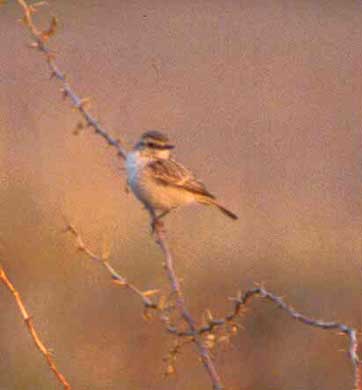
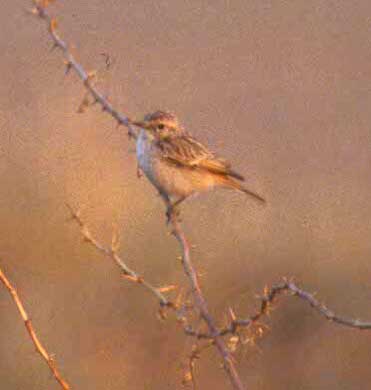
WHITE-BROWED BUSHCHAT Saxicola macrorhyncha
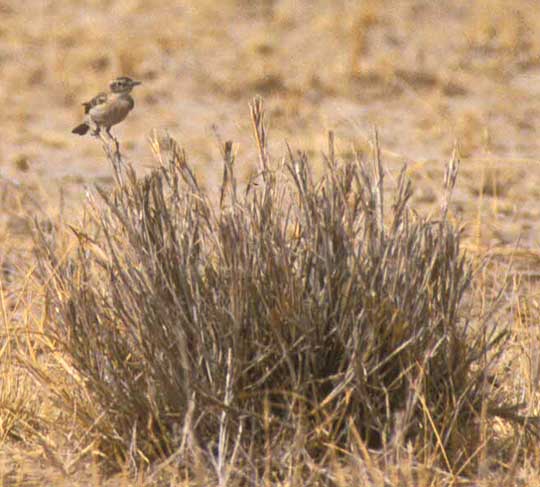 The White-browed or Stoliczka's Bushchat is a scarce and local endemic
of dry semi-desert of the Indian subcontinent. Most recent records have
been from Rajasthan, India, and particularly from Desert National Park
near the Pakistan border, where it occurs alone or in pairs, perching on
the tops of exposed bushes and dropping to the ground to feed. My
photo (left; apparently a female) from Desert NP captures this typical
behavior. A nice summary by Rahmani (1993) details its current status and
distribution, listing 31 known localities in western India. It inhabits
desert plains where ground-cover is 25-50% according to Birdlife International's
(2000) Threatened Birds of the World which lists this species as
"Vulnerable." The world population is estimated at 2,500-10,000 birds
and declining. The species is threatened by habitat loss and degradation.
The White-browed or Stoliczka's Bushchat is a scarce and local endemic
of dry semi-desert of the Indian subcontinent. Most recent records have
been from Rajasthan, India, and particularly from Desert National Park
near the Pakistan border, where it occurs alone or in pairs, perching on
the tops of exposed bushes and dropping to the ground to feed. My
photo (left; apparently a female) from Desert NP captures this typical
behavior. A nice summary by Rahmani (1993) details its current status and
distribution, listing 31 known localities in western India. It inhabits
desert plains where ground-cover is 25-50% according to Birdlife International's
(2000) Threatened Birds of the World which lists this species as
"Vulnerable." The world population is estimated at 2,500-10,000 birds
and declining. The species is threatened by habitat loss and degradation.
The northeasternmost site listed by Rahmani (1993) is Sultanpur Jheel
in Haryana state; the species likely occurs there only irregularly. However,
on 5 Feb 2001 Bill Harvey posted a note to the "Delhibird" chat line about
a male Stoliczka's Bushchat "moulting into breeding plumage" that had just
been discovered in the dry grasslands at the south end of Sultanpur Jheel,
and this message was reposted on the "Oriental Birding" chat line to which
I had subscribed in preparation for a March-April trip to India with three
birding friends. The chance to chase this rarity so intrigued us that we
changed our plans and spent our first afternoon in India at Sultanpur Jheel
before heading north to Corbett NP. Sultanpur Jheel proved to be a great
choice for a first day's birding in India (among us only I had ever been
to India before) and near dusk Dan Singer & I refound a bushchat right
where Harvey's directions said it was (although we had misinterpreted them
for some time and spent a lot of time in the wrong spot). The photos below
are of that Sultanpur Jheel individual. They are not the world's greatest
shots as they were taken in low light near dusk.


What most intrigued us about the Sultanpur Jheel bird is that it was not in "breeding plumage" and did not look very much like the paintings in either of the new field guides, Grimmett et al. (1998, 1999) or Kazmierczak (2000). The bird more nicely matched the photos in Rahmani (1993; we had copies with us). We had been searching for a male "moulting into breeding plumage" but the bird looked for like a female to us. We came upon with a theory to explain this anomaly. Breeding plumage could be acquired through wear rather than molt (Ali & Ripley 1987; true for several other Saxicola, see Cramp 1988). Therefore we wondered if the molting bird seen in February was molting out of alternate plumage into basic plumage in a post-breeding (pre-basic) molt, or we found a different White-browed Bushchat. This theory was posted to "oriental birds" chat line on our return. What we have since learned from Bill Harvey & Nikhil Devasar is that we had found a newly arrived female (first found that morning) and that the male had disappeared (possibly taken by a predator) before they paired. Indeed, the male had been seen the very morning we were there but never afterwards! Nikhil Devasar had already posted some photos of the male on the 'Net; he has kindly permitted me to reprint a couple of them below.
Rahmani (1993) says "nothing is known of its breeding habits" which mirrors the statement by Ali & Ripley (1987). The molt schedule is not known. Most specimens are apparently from January-February (Rahmani 1993) which might also explain the darker field guide paintings (presumably drawn from specimens). It may be that, unlike Common Stonechat, the White-browed Bushchat has a pre-alternate molt but this remains a mystery to date.
A female White-browed Bushchat or a male in fresh basic plumage can be overlooked among the abundant Common Stonechats S. torquata but is decidedly longer-billed and much paler and, of course, has a much more prominent supercilium (plus a broad pale eyering). Compare this March stonechat (below left; photographed at Bharatpur) with the Sultanpur bushchat (below right). The Common Stonechat shown is a male (pale-throated females are more likely to be confused) but note particularly the bill shape.
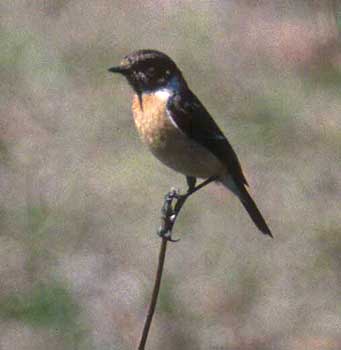
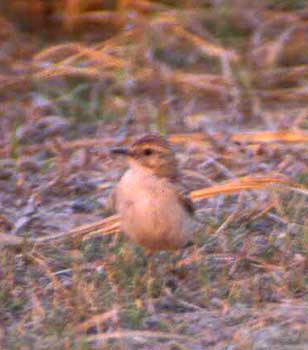
One other i.d. point of interest was noticed. The Sultanpur Jheel bushchat had a rufous wash to the rump and uppertail coverts but S. macrorhyncha is said to be white-rumped by Kazmierczak (and van Perlo paints it that way). The short text in Grimmett et al. (1999) does not address this point but in Grimmett et al. (1998) a rufous-buff wash to the uppertail coverts is described. Ali & Ripley (1987) state that the uppertail coverts are "white or rufous-white" -- both guides could thus be right -- or it may be that the rufous wash is most prevalent in fresh basic plumage and wears to white with time. All in all, an interesting bird.
PHOTOS: The Sultanpur Jheel female was photographed 11 Mar 2001; the Desert NP individual on 28 Mar 2001. These are © 2001 Don Roberson. The Sultanpur Jheel male was photographed in Feb 2001 by Nikhil Devasar who holds that copyright (used with permission), all rights reserved.
Literature cited:
Ali, S., and S. D. Ripley. 1987. Compact Handbook of the Birds of India and Pakistan. Oxford Univ. Press, Delhi and Oxford, U.K.TOPBirdlife International. 2000. Threatened Birds of the World. Barcelona & Cambridge, U.K., Lynx Edicions & Birdlife International.
Cramp, S., ed. 1988. Handbook of the Birds of Europe, the Middle East, and North Africa: the Birds of the Western Palearctic. Oxford Univ. Press, Oxford, U.K.
Grimmett, R., C. Inskipp, and T. Inskipp. 1998. Birds of the Indian Subcontinent. Christopher Helm, London.
Grimmett, R., C. Inskipp, and T. Inskipp. 1999. Birds of India, Pakistan, Nepal, Bangladesh, Bhutan, Sri Lanka, and the Maldives. Princeton Univ., Princeton, N.J.
Kazmierczak, K., and B. van Perlo. 2000. A Field Guide to the Birds of the Indian Subcontinent. Yale Univ. Press, New Haven, CT.
Rahmani, A. R. 1993. Little-known bird: White-browed Bushchat. Oriental Bird Club Bull. 17:28-30.